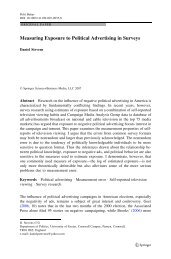speech and respect - College of Social Sciences and International ...
speech and respect - College of Social Sciences and International ...
speech and respect - College of Social Sciences and International ...
You also want an ePaper? Increase the reach of your titles
YUMPU automatically turns print PDFs into web optimized ePapers that Google loves.
Notes<br />
12 New York Times A19 (January 25, 1991). A Moscow brokerage house<br />
advertisement for women secretaries, 18-21 years old, told them to wear<br />
a mini-skirt to the interview. An advertising firm seeking a receptionist<br />
asked women to submit full-length photos, preferably in a bikini to<br />
display their "full super-attractiveness." New York Times 13 (September<br />
12, 1992) (oped).<br />
13 New York Times B12 (December 11, 1991).<br />
14 New York Times B1 (April 15, 1992).<br />
15 New York Times 1 (February 15, 1992).<br />
16 New York Times B1 (January 23, 1991).<br />
17 New York Times s. 1 p.69 (December 15, 1991). Dalma Heyn's The Erotic<br />
Silence <strong>of</strong> the American Wife (1992) was much ballyhooed as a call for<br />
eliminating the double st<strong>and</strong>ard by ending monogamous fidelity for<br />
women as well as men.<br />
It's about time women gave voice to all their dimensions, including the<br />
erotic, without shrinking in guilt. (Gail Sheehy)<br />
Dalma Heyn has shown us a new reality <strong>and</strong> a tantalizing hint <strong>of</strong> the<br />
future—<strong>and</strong> neither women nor marriage will ever be the same. (Gloria<br />
Steinem)<br />
Heyn reminds us ... that women are sexual beings <strong>and</strong> that, for<br />
women as well as men, sex is a fundamentally lawless creature, not<br />
easily confined to a cage. (Barbara Ehrenreich)<br />
Dalma Heyn exposes the lie that men, by nature, play around <strong>and</strong><br />
women, by nature, are monogamous. (Louise Bemikow)<br />
New York Times B2 (June 17, 1992) (advertisement).<br />
Male actors, singers, <strong>and</strong> athletes have always been sex objects.<br />
Women law students comment on cute male pr<strong>of</strong>essors in teaching<br />
evaluations <strong>and</strong> bathroom graffiti. Now other male performers are seeking<br />
to exploit their sexuality. EMI Classics promoted Tzimon Barto's "Chopin<br />
Preludes" with publicity photos showing him without a shirt. The female<br />
vice president <strong>of</strong> marketing explained: "What we are trying to do is<br />
represent the artist as a whole person. Not only does he play the piano<br />
beautifully, but he's also a body builder ..." Trying to make a Swiss<br />
harpist "a sex symbol <strong>of</strong> classical music," the company photographed<br />
him in bed with his harp. The performer conceded: "we try to use the fact<br />
that I'm young, that I do sports, I lift weights, whatever to catch the<br />
attention <strong>of</strong> the people to listen." New York Times B4 (September 14,<br />
1992).<br />
18 Walker (1980); Teish (1980); Crenshaw (1991). Consider the reaction <strong>of</strong><br />
black men to Alice Walker's The Color Purple (both the novel <strong>and</strong> film), or<br />
<strong>of</strong> the black women in Spike Lee's "Jungle Fever" to the interracial love<br />
affair. See also Campbell (1992) <strong>and</strong> the reader response. New York<br />
Times Magazine 12-13 (September 13, 1992) (letters to The Editor).<br />
19 Mercer (1990: 45^9).<br />
20 Camille Paglia has cynically pursued an academic <strong>and</strong> media career by<br />
attacking feminism. She recently wrote that "every woman must take<br />
153

















